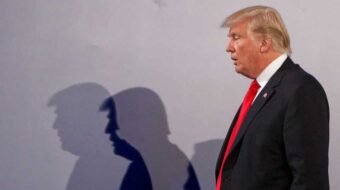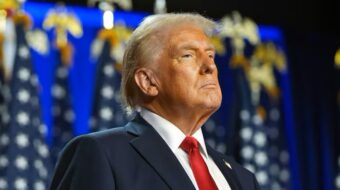
Black lives measured in dollar signs
The week of July 4 will likely be looked upon as one of the most racially turbulent of 2016. In the course of seven days, the United States collectively bore witness to two Black men, Alton Sterling and Philando Castile, being shot and killed by police officers on camera in graphic video footage. In the same week, the world witnessed on the news and on social media outlets the chaos that broke out after a sniper shot and killed five police officers and wounded seven more officers and two civilians during a peaceful Black Lives Matter protest in Dallas. These events have produced shock waves throughout the country reminiscent of the outrage after Michael Brown was murdered by a police officer in Ferguson, Missouri, in August 2014. Black America has continued to be a major target of police brutality, as the deaths of African Americans at the hands of law enforcement continue at an alarming rate.
Resistance is also mounting. In this same week of tragedy we have seen diverse crowds of thousands pour out into the streets from Oakland, Atlanta , St. Paul , Baton Rouge, and other cities, demanding a concrete road forward. As a People’s World editorial noted last week, we are at a tipping point of dealing with how America confronts race. Which direction it will tip shall have a lasting effect on our future.
America’s ever-present problem of race goes beyond individual instances of police brutality. The lasting history of chattel slavery that chained Black bodies, the creation of Jim Crow segregation, and the new Jim Crow of the Prison Industrial Complex all emerged under a system that depends heavily on exploitation for profit. This exploitation and oppression has left much of the African American population in low wage jobs, poverty, and at a higher risk for incarceration. As the Black Lives Matter movement continues to fight for Black liberation and equality, the issue of what that means under a system that puts profit before people also has to be addressed.
Does our profit-driven economy depend on the oppression of Black people? Will that oppression end only if we change our economic system? What exactly does “black lives matter” mean under capitalism?
The exploitation of Black America from slavery through Jim Crow Segregation
It is not outlandish to state that from colonial times to the mid-1800’s, the majority of the wealth in the United States was created by slave labor. Without slave labor, there would be no United States.
The American War of Independence from 1775 to 1783 saw the United States establish itself separate from Britain on the basis of liberty and freedom, but it would be on the ideals of slavery and oppression that the nation would achieve the beginning of its true economic power.
Although the country came from under the rule of the British monarchy, it would hold court with “King Cotton” at the expense of Black people’s freedom.
Officially the slave trade lasted for three centuries: from 1550 to 1850. According to the Trans- Atlantic Slave Trade Database, 12.5 million Africans were shipped to North America, the Caribbean and South America. 10.7 million survived the Middle Passage (the transatlantic ship voyage that could last from one to six months), disembarking in the so-called New World. Of those 10.7 million, it is estimated by the database, which is based at Emory University and headed by Professor David Eltis and Martin Helbert, that roughly over 300,000 landed in the United States. This growing population of enslaved laborers would play a key role in shaping the newly formed United States economy.
As philosopher/economist Karl Marx stated in his 1846 work entitled The Poverty of Philosophy, “Direct slavery is just as much the pivot of bourgeois industry as machinery, credits, etc. Without slavery you have no cotton; without cotton you have no modern industry. It is slavery… and it is the world trade that is the precondition of large scale industry. Thus slavery is an economic category of the greatest importance.”
By 1840, the U.S. South grew 60 percent of the world’s cotton and provided up to 70 percent of the cotton consumed by the British textile industry. The North developed businesses that provided services for the South where cotton ruled, including textile factories, a meat processing industry, insurance companies, shippers, and cotton brokers. American economic growth at this time owed its basis largely to the capital, iron, and manufactured goods that enslaved labor produced.
The end of the Civil War, which saw the abolition of slavery, would usher in the Reconstruction Era, also known as Radical Reconstruction, from 1865-1877. If there was ever a time for concrete legislative change to take place, one could argue the era of Reconstruction was it. This era would see the enfranchisement of African Americans in various sectors in the South such as government and business. Gains were made, such as the passing of the Enforcement Acts, which protected African Americans’ right to vote, to hold office, to serve on juries, and receive equal protection under the law.
However, the implementation of these laws depended heavily on the protection of the federal government through the presence of troops in the South to ward off violence from the descendants of slaveholders. These elite whites encouraged racism among poor whites for fear they would join forces with newly freed African Americans. Rich whites formed and ran the Ku Klux Klan, for example. Poor whites joined it.
Yet the livelihood and protection of Black lives was negotiated away in exchange for political gains. In the infamous Compromise of 1877, Democrats and Republicans negotiated the outcome of the presidential election of 1876, wherein the White House was given to Rutherford B. Hayes on the condition that federal troops be removed from the South. Without the protection of the U.S. military, Radical Reconstruction officially came to an end, and in its place came Jim Crow segregation.
Famed scholar W.E.B Du Bois remarked at one time that Radical Reconstruction had been a “splendid failure” and noted in his work entitled Black Reconstruction: “The slave went free; stood a brief moment in the sun; then moved back again towards slavery.” Jim Crow segregation would see a series of laws that divided people by race and oppressed African Americans in nearly every way of life. Coupled with this was the prevalent terror and violence against Black Americans by the Ku Klux Klan and other white supremacist groups. These laws and violence had lasting effects, even as late as 1954, when the decision of Brown v. Board of Education brought what many considered the end of Jim Crow segregation.
Thus far, in many of these instances, throughout history we have seen Black Americans being subjugated for the economic and political gain of others. Their lives have “mattered” only insofar as their labor and oppression could benefit others. This is displayed in full effect when looking at what legal scholar Michelle Alexander has termed the New Jim Crow of the Prison Industrial Complex.
Prisons as the new plantations
According to the Bureau of Justice Statistics, one in three black men can expect to go to prison in his lifetime. One in every 15 African American men is incarcerated in comparison to one in every 106 white men as of 2012. Thirty percent of women prisoners are African American, although they make up only 13 percent of the general female population in the United States. Black women are incarcerated at 4 times the rate of white women. If chattel slavery was outright black enslavement based on race, then the Prison Industrial Complex can be seen as a newer wave of captivity of Black bodies.
As Alexander explains in The New Jim Crow: “African Americans repeatedly have been controlled through institutions such as slavery and Jim Crow, which appear to die, but then are reborn in new form, tailored to the needs and constraints of the time.” That seems to be the case with mass incarceration as more and more Black Americans become disenfranchised once finding themselves with criminal records, or worse, serving time in prison and providing free (or nearly free) labor for the state.
Alexander explains that through the war on drugs of the Reagan, Bush and Clinton years, “More than 2 million people found themselves behind bars at the turn of the twenty-first century, and millions more were relegated to the margins of mainstream society … Ninety percent of those admitted to prison for drug offenses in many states were black or Latino.”
With the drug war has come a multi-billion dollar industry: for-profit prisons. The more prisoners, the more profits. One of the largest groups lobbying governments at all levels today represents private prison owners.
This new Jim Crow does not only place people, mainly African American and Latino, in prison physically, but traps them in a vicious set of constraints financially and politically for the rest of their lives if they are faced with a felony charge. As Alexander notes, although approximately 2.3 million people are in prisons, an additional 5.1 million are under “community correctional supervision” or probation/parole.
Alexander explains that once they are in this system, citizens often find themselves in societal exile: “Barred from public housing by law, discriminated against by private landlords, ineligible for food stamps, forced to ‘check the box’ indicating a felony conviction on employment applications for nearly every job, and denied licenses for a wide range of professions.”
It is no wonder then that many find themselves back in prison after having found no fruitful alternative to making ends meet as they can not find sustainable work and housing.
Others mistakenly end up back in the system after failing to follow protocols when checking in with their parole or probation officer, or falling behind on the fines and fees because they cannot find consistent work.
Sociologist Loïc Wacquant in his Journal article “The New ‘Peculiar Institution’: On the Prison as Surrogate Ghetto” described this vicious cycle as a “closed circuit of perpetual marginality.” The matter is further exacerbated as the arm of the law, police officers, are put in place to ensure that this cycle continues. Their policing finds itself intertwined with the revenue of their respective cities.
A reporter for Mother Jones coined the term “policiteering” to describe the way in which officers go about their jobs. The article states that “one begins to see that lurking beneath this violence is a fiscal menace: police departments forced to assist city officials in raising revenue, in many cases funding their own salaries — redirecting the very concept of keeping the peace into underwriting the budget.”
Examples of this can be seen in places like Ferguson, Missouri, where a Department of Justice study found that revenue from police-issued tickets represented the city’s second-largest source of cash. In 2013 fines brought in $2.2 million for the city. Or in San Diego, where a simple parking ticket of $35 can quickly escalate to $235 when other fees are placed on it by government agencies. African Americans and Latinos make up less than a third of San Diego’s population but represent 64.5 percent of those searched during a traffic stop.
It is clear from just a few of these statistics that increased policing of Black Americans can be tied to financial incentive. “Protect and serve” is more often “police and charge” as Black Americans can find themselves paying the price with either their hard earned money or their lives.
Deeper than policing
Through a brief look at history we can see that the oppression and exploitation of Black people have correlated with profit for those in political or economic power. The prison industrial complex sees many Black Americans finding themselves in a new form of indentured servitude to the government. How then can a movement, such as Black Lives Matter, effectively fight for equality under a system that stands to make its continued profit from the subjugation of black bodies?
As stated earlier, the United States was fueled by the enslaved labor of Black people. One can argue that the nation’s continued power continues to be fueled by this- now under the guise of coded legal maneuvers. America does indeed have a race problem, but the way to handle that problem would appear to be deeper than simply addressing the way police are trained to deal with African Americans. We as a country have to truly grapple with the layers of systemic racial discrimination and reveal who profits from this discrimination. It is not an easy task, but a needed one.
As W.E.B Du Bois explained over 50 years ago in his work The Suppression of the African Slave Trade: “…We have and shall have, as other peoples have had, critical, momentous, and pressing questions to answer. The riddle of the Sphinx may be postponed, it may be evasively answered now; some time it must be fully answered.” This holds true today.
Black Americans cannot afford, both figuratively and literally, to have America’s problem of race inequality continuously pushed off.
In the next installment: The next article will deal with the history of the movements that have come about in the fight for racial equality since the country’s inception. It will also touch upon the emergence of Black Lives Matter and the effectiveness of its demands under capitalism.
Photo: Desiree Griffiths at an event in Miami, Fla. | AP












Comments